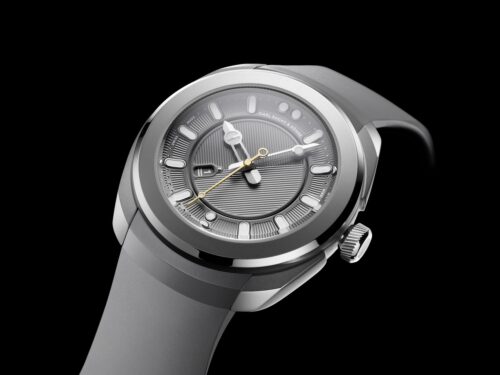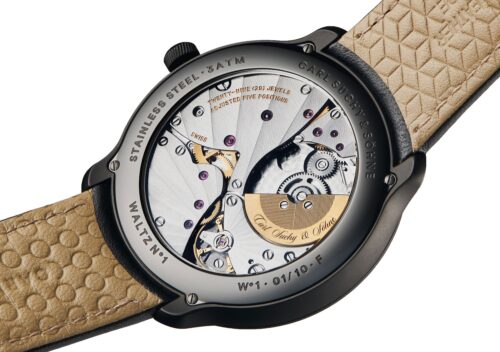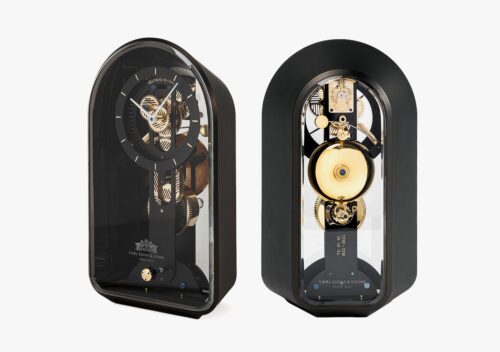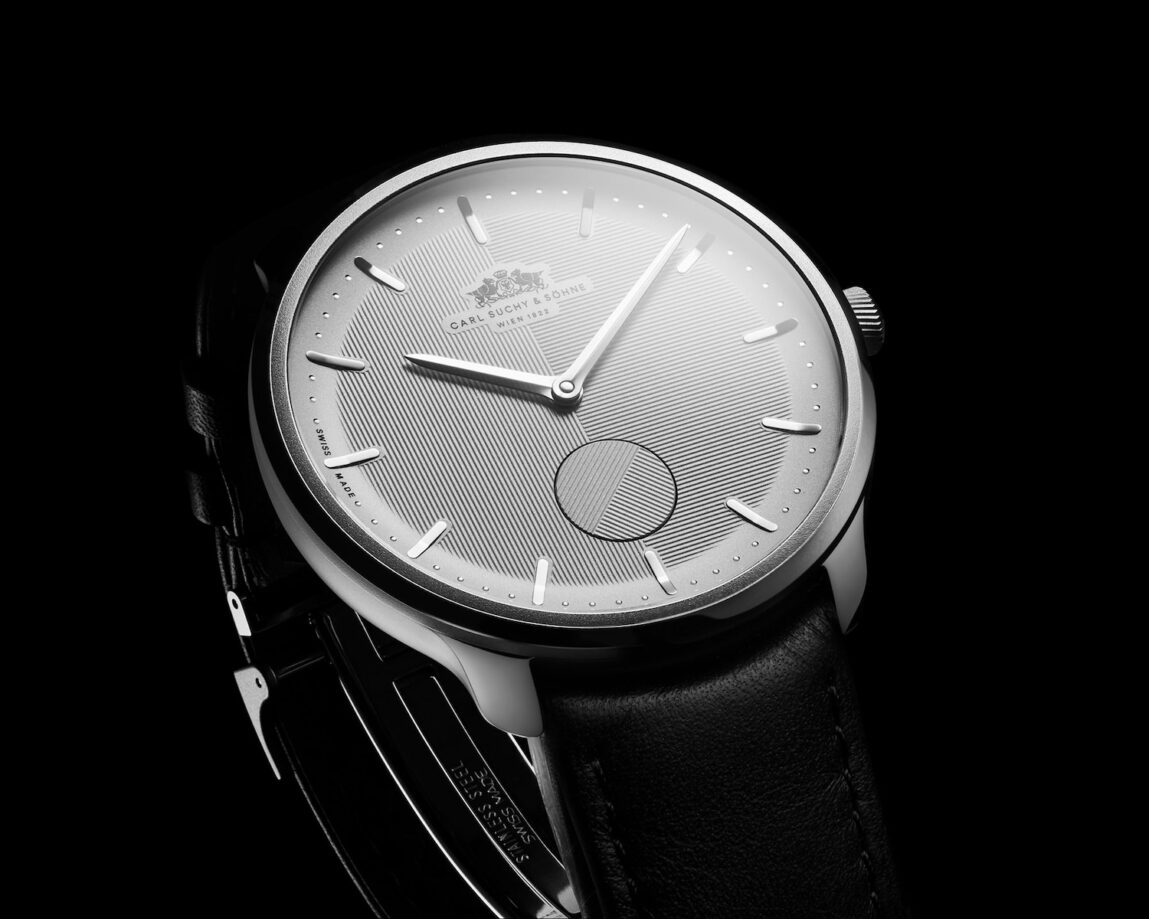»I love Vienna!«, Robert Punkenhofer sums up his very special relationship with the Austrian capital—and, after a short pause, laughingly adds a very important side note: »…but only if I can get out regularly«. A statement that probably very aptly sums up the special connection of the art and design expert with an international reputation to a city that is not only a source of inspiration, but also a central building block of his work.
In 2017, Robert Punkenhofer revived the traditional watch brand Carl Suchy & Söhne, which was originally founded in Vienna in 1822. Once a purveyor to the imperial family, the company was considered the most important watch manufacturer in the Danube Monarchy in the 19th century and also enjoyed international renown, which only dried up with the end of the Austro-Hungarian Empire. With a clear vision, Punkenhofer has now revitalized the brand and brought it into the 21st century: Watches of the highest quality, conceived as a tribute to Viennese elegance and inspired by the era of Wiener Moderne (Viennese Modernism) in dialog with contemporary design.

Carl Suchy & Söhne was once the most important supplier for clocks and watches in the Danube Monarchy and stood for the highest quality and precision—even Emperor Franz Joseph I was one of the watchmaker’s regular customers.
With three collections since the relaunch, Carl Suchy & Söhne has already successfully established itself as a niche brand characterized by quality, historical and cultural depth and a strong design identity. In an interview with Chapter, Robert Punkenhofer talks about the challenges and ambitions of this brand revival, his personal connection to Vienna and the role of art and design in creating a timeless identity.
Chapter How do you define the DNA of the Carl Suchy & Söhne brand, even apart from the brand’s historically numerous prominent customers?
Robert Punkenhofer The DNA for me was very clear: Carl Suchy & Söhne was the most important watch manufacturer of the Danube Monarchy, not without a reason purveyor to the court for three generations and offered customers the highest quality. That is the DNA for me. So ultimately: »The Emperor’s Choice«.
Chapter Which original design details were essential for you during the relaunch in order to maintain the authenticity of the brand?
Robert Punkenhofer For me, the design details are less about historical watches that we have in our archive, because the premise for us was to carry on the fire of Carl Suchy and not the ashes—after all, he was one of the most outstanding, creative and innovative entrepreneurs of his time. That’s why the original design was less important to me than the positioning: I wanted to be back where Carl Suchy was, namely at the highest level. And we are not simply copying the original designs and reissuing the same watches. Quite the opposite: we are continuing the story and picking up where Suchy left off, i.e. Biedermeier. And what came after that: Wiener Moderne, Secession, Viennese Jugendstil—and that’s where we took our design approach, i.e. our watches are very much inspired by Vienna around 1900 with the formative architecture and art scene around Hoffmann, Klimt, Schiele, Loos, Wagner etc. But again, it’s not a copy, it’s a recreation, charged and relevant for the 21st century.

A highlight of the Belvedere collection is the development of the date display, in which the date window moves forward every day.
Chapter How did you navigate the tension between historical 19th century watch design and contemporary trends, particularly with regard to the sporty Belvedere line?
Robert Punkenhofer With the Belvedere in particular, it was important for us to remain true to our design approach, i.e. to create a watch based on Wiener Moderne that is clearly recognizable as a Suchy—for example by the halved guillochage on the dial and many small details such as the polished and sandblasted surfaces. And on the other side, when we turn the watch over, we see the golden rotor, the Golden Vienna, so to speak, the classic baroque, with the micro-engraved façade of Belvedere Palace. A duality of simplicity, effortless elegance, and the emotional, such as the golden rotor, the golden retaining ring, but also with little twists, such as the date window, which keeps turning and thus provides a new perspective on the watch every day.
Chapter To what extent does the design of the dial you described as a central element reflect the revival of the brand identity and »Viennese elegance«?
Robert Punkenhofer The dial is indeed elementary, it is the face of the watch. It was essential for us to create a simple elegance, a Viennese elegance, with flowing transitions from the dial to the case, from the glass to the dial, from the strap lug to the steel case or titanium case. Flowing transitions like those created by Adolf Loos in Wiener Moderne, for example, or Josef Hoffmann. And then, of course, the small design details of the dial were also important to us, which shine through everywhere in our collections and make them recognizable, as with the waltz disc on the Waltz N°1, or mentioned date window, which moves on at midnight.

The design of the Waltz N°1 wristwatch is inspired by Viennese architect Adolf Loos and is intended to combine the timeless elegance of Wiener Moderne (Viennese Modernism) with the highest level of Swiss craftsmanship.
Chapter You always emphasize the brand’s historically strong Viennese roots, the inspiration from formative Viennese art and cultural trends and classic Viennese elegance. What connection do you personally have to Vienna and how does this influence the brand identity of Carl Suchy & Söhne?
Robert Punkenhofer Well, I’m not Viennese, I’m actually Styrian, but of course Vienna has always fascinated me, even as a young student. I’ve also been active in the design and art world in Vienna for many years, for example I founded Vienna Art Week 20 years ago and was managing director of the Austrian Design Foundation in Vienna. And through this involvement with creative Vienna, with the creative industries, I developed a very, very strong connection to the city. Long before the revival of Carl Suchy & Söhne, it was a dream of mine to revive a historic brand. Based on a strong history, a strong legacy, to create something relevant, something new. I love Vienna! … But only if I can get out regularly. (laughs)

The mechanical movement of the traditional Swiss watchmaker Vaucher Fleurier is visible through the scratch-resistant sapphire crystal case back of the Waltz N°1.
Chapter How has this professional background as an art and design expert that you have just described shaped your view of the art of watchmaking and what role does your extensive experience and expertise in this field play in the positioning of the brand?
Robert Punkenhofer On the one hand, this is a very important influence and also an important basis for my work. On the other hand, I have to admit that I couldn’t really seek synergies from this »cutting-edge« art and design world when relaunching Carl Suchy & Söhne, because the brand’s DNA and philosophy are naturally positioned much more conservatively. On the other hand, with regard to young designers, such as Milos Ristin, who designed the first watches, or now with Eric Giroux, my influence from art and design projects that I have implemented in the past is also very recognizable. Especially when it comes to constantly challenging yourself and questioning what you can do better, better, more beautifully. Because we want to build a really beautiful brand that isn’t always just about whether we can make money with it, but as my motto has always been »Meaning is more than money«.
Chapter What challenges did you face during the revival of Carl Suchy & Söhne?
Robert Punkenhofer From my point of view, the challenges were not that great, because I am also used to creating beautiful things out of nothing, so to speak. Perhaps also because in my previous job as a diplomat and business delegate, it was always important to put out feelers, build up new networks and connect with interesting people—in this case, watchmakers, designers, etc. The real challenge was actually to still be alive after a year. We are now in our seventh year and have already managed to build up three collections and win customers in over 20 countries. When I think back, the biggest challenge to date has actually been to build up this network and a community of people in the watch industry, dealers, opinion leaders, whether journalists or collectors. In the end, I really underestimated that. I thought to myself, I know how it works in the art world, I know how it works in diplomacy, it won’t be much different in the watch industry. But it is still a special segment and also a very closed circle to some extent.

An unusually bold statement: after more than 100 years, Carl Suchy & Söhne launched the Table Waltz, a table clock designed to fill any room with Viennese charm.
Chapter How would you describe the target group that you want to address with Carl Suchy & Söhne?
Robert Punkenhofer Our target group is very clear: passionate watch collectors who already have the usual brands in their homes, so perhaps already have a Rolex or a Patek Philippe, and are now looking for something special—a niche that is much more exclusive. We make a few hundred watches a year, while Patek Philippe makes around 70,000 and Rolex over a million. Our customers are looking for watches that are special in terms of design and heritage, that tell a different story than any other Swiss watch brand. We are the Austrian watch brand, we are the Viennese watch brand. And our customers are, so to speak, »People in the know«, sophisticated, intellectual and well-traveled. In terms of mindset, someone who is looking for something special, who doesn’t prefer »bling bling« and »into your face«, where everyone should immediately recognize that I have a Rolex, but who, on the contrary, is happy to know what special thing he is wearing on his wrist and it is not at all important to him that others immediately recognize it.
Chapter And how do you want to ensure that the brand remains relevant for both watch enthusiasts and collectors in the long term?
Robert Punkenhofer I think we can only create this relevance and desirability for our watches by delivering fantastic quality—in terms of design, in terms of movements, but also in terms of positioning, creating a brand world that offers something special. And I believe that with our symbolic value around our history, around Vienna, around our design language, we will hopefully be able to win over many new collectors in the future—enthusiasts, collectors and fans. [CS]

